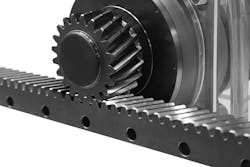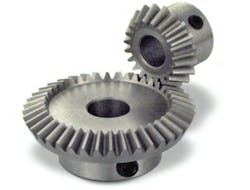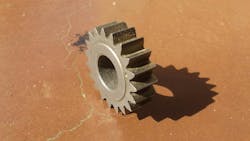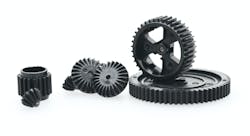If you've ever sat down for Sunday dinner in an authentic Italian American home, you know not to question the red sauce known as “Grandma's Gravy.” This tomato-based elixir coating your pasta is a gift from heaven itself. But the ketchup served with your French fries at the local fast food drive-thru is also a “sauce” made from tomatoes. Therefore, they must be interchangeable, right? Absolute sacrilege!
This same type of comparison occurs all too frequently with gear materials; there are certain materials that are universally suitable for gearing, but others that are only appropriate for specific applications.
Gear Racks
Gear racks are most frequently produced from carbon steel. This is a very suitable material for racks in most environments and under most use conditions. The reason that this material works well is due to the relative strength of the rack tooth in combination with the pinion. In almost every application, the pinion is inherently the weaker member in the mesh and will fail long before the rack.
The material also lends itself to being heat-treated for additional strength, permits the addition of threaded or bolt holes, maintains dimensional stability, and can be straightened if necessary.
For washdown or in food environments, stainless steel is frequently used. This material shares all the attributes of carbon steel except for the ability to be heat-treated for additional strength.
In some applications, a plastic rack is used if there's a need for the rack to be self-lubricating or to reduce system weight. These racks are very durable and useful only when selected for the proper environment.
For example, an acetal rack will not maintain its straightness over a long length (>3 feet [1 m]) and is known to have the possibility of voids. This makes adding bolt holes or threaded holes a risk. Alternatively, a nylon rack will not maintain its dimensional accuracy when exposed to varying temperatures or changes in humidity, as this material reacts to both temperature and moisture.
For a direct replacement, based on the relative tooth strength, a nylon gear rack will need to be six times larger than a carbon steel rack in order to handle the same loading.
Driving Gear
For gearing that operates as a friction mechanism, such as a worm gear pair, it's critical that the drive gear has a surface strength (durability) that is greater than that of the driven gear. Because of this requirement, most worms are made from carbon or alloy steel and most worm wheels are made from bronze, cast iron, or aluminum bronze.
Consider a 60:1 worm gear pair. In this arrangement, the worm will be rotating one tooth in and out of mesh, continuously. However, the worm wheel will be engaging just one tooth every revolution. Therefore, each tooth of the worm wheel has a duty cycle of one worm revolution engaged and 59 revolutions disengaged. This implies that the worm needs to have a durability 60 times greater than the wheel.
If the wheel was produced from a material that has the same durability as the worm, the worm would fail in an accelerated manner due to scoring. This is a condition that occurs when metal-to-metal contact causes the tooth flanks of the gears to weld together. This process pulls metal from the pair and begins to scratch the tooth surface in the sliding direction. Although proper lubricant can minimize scoring, using materials that allow for heat dissipation is the better design consideration.
Bevel Gears
Bevel gears are typically used in high torque environments and are therefore usually produced from carbon steel, stainless steel, or alloy steel. However, there are applications where acetal or nylon bevel gears are suitable, such as R/C helicopters, hand-crank applications, or for mass-produced toys.
Plastics can be used to produce straight tooth bevel gears, but they cannot be used to produce spiral bevel, Zerol bevel, or hypoid bevel gears, as the material would deform because of the heat generated by the cutting process.
Spur Gears
Spur gears are the most popular form of gearing and can be produced in almost any material. Gears produced 100 years ago were typically produced from cast iron as it was an economical method for producing change gears for industrial equipment. Materials commonly used today are various types of steel, plastic, and specialty metals.
Spur gears are also produced from titanium, Inconel, and other exotic alloys for classified military and space applications.
Carbon Steel Gears
Carbon steel gears are economical and suitable for most applications as the material offers moderate strength, low cost, and ease of machinability. Stainless steels also offer moderate strength and ease of machinability but at a higher material cost. Some stainless steels are also non-magnetic.
Alloy steels offer superior strength and can be hardened for superior durability but at a high raw material cost. All carbon steels, some stainless steels, and most alloy steels can be heat treated to improve surface durability. All steels are dimensionally stable and suitable for keyways and tapped holes.
Acetal Gears
Acetal gears are typically the most economical, as they are generally injection molded. The moderate cost of raw material and low cost of machining make this a common material for prototyping.
Acetal is a very dimensionally stable plastic due to its low absorption of moisture, but it's recommended that acetal gears not be subjected to shock loading as they are less resilient to impact.
Nylon gears are common in power transmission applications due to the material’s moderate cost, ease of machining, self-lubricating properties, and vibration-absorbing abilities. Nylon gears are sometimes made from reinforced nylon and depending on the reinforced material, a nylon gear can improve its bending strength by 30 to 90%.
Fiberglass-filled nylons maintain self-lubricating and weight-saving properties, reducing dimensional growth due to temperature and moisture, and increasing bending strength by 30%, albeit at a 50% increase in raw material cost.
Carbon fiber-filled nylons also maintain self-lubricating and weight-saving properties, greatly reducing growth due to temperature and moisture, and increasing bending strength by 90%. However, the raw material cost is at least 600% more expensive than unfilled nylons.
As detailed in the examples above, there are many distinct materials for gearing. Each has a purpose and each application will dictate what material should be selected. So please don’t put ketchup on your spaghetti.








